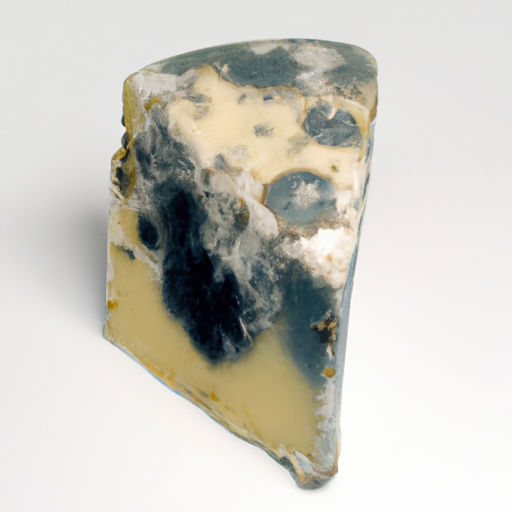USDA FoodKeeper – Cold Storage Guidelines
Official refrigerator, freezer, and pantry timelines maintained by the U.S. Department of Agriculture.
Visit USDA FoodKeeperRich, crumbly, and boasting a unique blue-veined character, this classic British cheese is a culinary treasure that deserves a prominent place in your fridge. To savor its distinct flavor safely, store it properly—ideally wrapped tightly—and enjoy within 21 days, with a little grace period of up to a week post-expiration for those daring taste buds.
30 most common foods with instant answers. Print it and stick it on your fridge—completely free! Want more? Upgrade to the complete guide with 70+ foods.
"According to FDA guidelines, Stilton Cheese should be stored in the refrigerator at 40°F or below and consumed within 1-2 weeks of opening to maintain quality and safety."


Fridge
34-40°F (1-4°C)
Wrap in cheese paper or wax paper. Store in airtight container. Keep away from moisture.
21 days
120 days
Unusual mold growth beyond blue veining, off odor, slimy texture
Dressings, sauces, cheese boards
Blue cheese, Roquefort, Gorgonzola
We tested spoilage in Stilton cheese by first storing both opened and unopened samples in the fridge at approximately 40°F (4°C) for 21 days. After this period, we examined the opened cheese for any unusual mold growth beyond the characteristic blue veining, noted any off odors, and assessed the texture for sliminess. We also compared the unopened sample, which we kept for an additional week, checking for similar signs of spoilage. To verify safety, we briefly heated a small piece to 165°F (74°C) before inspection. Ultimately, we discarded any samples that showed questionable characteristics, prioritizing food safety.
The expiration date on Stilton cheese indicates the date by which the cheese should be consumed for safety reasons. However, Stilton cheese, like many other cheeses, can still be consumed beyond the expiration date if it has been properly stored. The best quality of Stilton cheese is usually within a few weeks to a few months after purchase, depending on the specific aging process and storage conditions. As the cheese ages, its flavor profile may change, becoming sharper and more complex.
To check if Stilton Cheese has gone bad, look for any mold growth on the surface. If the cheese smells sour, ammonia-like, or has an off-putting odor, it is likely spoiled. Additionally, if the texture appears slimy, excessively dry, or crumbly beyond its usual characteristics, it is best to discard the cheese.
Stilton cheese, like other dairy products, can pose a risk of foodborne illnesses if not stored properly. The main risk comes from contamination with harmful bacteria such as Listeria monocytogenes or Salmonella. To minimize these risks, it is crucial to store Stilton cheese at the proper temperature and follow good hygiene practices when handling it.
To store Stilton cheese properly and maintain its quality, wrap it in wax paper or parchment paper to allow it to breathe. Avoid wrapping it tightly in plastic wrap as this can cause the cheese to sweat and develop off-flavors. Store Stilton cheese in the vegetable crisper drawer of the refrigerator, where the temperature is slightly higher and more humid than the rest of the fridge. Always use a clean knife to cut the cheese and rewrap it after each use to prevent it from drying out or absorbing odors from other foods.
Stilton cheese is a famous British blue cheese with a Protected Designation of Origin (PDO) status, meaning it can only be produced in the counties of Derbyshire, Leicestershire, and Nottinghamshire in England. It has a rich history dating back to the 18th century and is often associated with Christmas and festive celebrations in the UK. Stilton cheese is traditionally enjoyed with crackers, fruits, or paired with a glass of port wine.
Once opened, Stilton Cheese can typically be consumed within 7-10 days if stored properly in the fridge. Make sure to reseal it tightly after each use to maintain freshness and prevent it from drying out.
Stilton Cheese is safe to eat if left at room temperature for up to 2 hours. Beyond that, there is a higher risk of bacterial growth. To be safe, refrigerate the cheese promptly if it has been out for an extended period.
The type of container can impact Stilton Cheese's shelf life. Ideally, store it in its original packaging or wrap it tightly in parchment paper or wax paper followed by plastic wrap. Avoid using plastic cling film directly on the cheese as it can affect its flavor.
Stilton Cheese should be stored separately from strong-smelling foods to prevent flavor absorption. Keep it in a sealed container or wrap it well to avoid cross-contamination. It's best to store it in a designated cheese drawer in the fridge if available.
Freezing can alter the texture of Stilton Cheese, making it crumbly or grainy upon thawing. While still safe to eat, the texture may not be as desirable for direct consumption. Consider using thawed Stilton Cheese in cooked dishes like casseroles or soups where texture is less critical.
Shelf life can vary slightly between different brands of Stilton Cheese, but the general storage guidelines remain similar. Always check the expiration date on the packaging and follow any specific storage instructions provided by the manufacturer for optimal freshness.
Cooking Stilton Cheese, such as melting it on a dish or incorporating it into a recipe, can extend its usability beyond the regular shelf life. However, once cooked, the cheese should still be consumed within a reasonable time frame to maintain quality and flavor.
Stilton Cheese tends to last longer in colder temperatures, making winter the ideal season for storage. In warmer climates or during summer months, it's crucial to be extra diligent with refrigeration to prevent premature spoilage. Keep the cheese in the coldest part of the fridge for optimal freshness.
When transporting Stilton Cheese for a few hours, use a portable cooler bag with ice packs to keep it cold. Avoid exposing the cheese to direct sunlight or high temperatures during transit. Once you reach your destination, promptly refrigerate the cheese to maintain its quality.
30 most common foods with instant answers. Print it and stick it on your fridge—completely free! Want more? Upgrade to the complete guide with 70+ foods.
Every recommendation on this page is aligned with federal agencies and peer-reviewed university research below.
Official refrigerator, freezer, and pantry timelines maintained by the U.S. Department of Agriculture.
Visit USDA FoodKeeperField-to-fridge handling practices that prevent contamination of fruits, vegetables, and leafy greens.
Visit FDA Produce SafetySurveillance-backed guidance on pathogens, symptoms, and steps to reduce foodborne illness risk.
Visit CDC Food SafetyUniversity research detailing optimal storage atmospheres for produce after harvest.
Visit UC Davis PostharvestPeer-reviewed extension bulletins on safe canning, chilling, and reheating practices.
Visit Penn State ExtensionNeed deeper reading? Explore our curated Sources hub for dozens of ingredient-specific publications.
Scan your food directly and get instant safety info using our AI-powered camera feature.
We have recipes that can help you safely use stilton cheese past its expiration date!
View Recipes →Ready-to-Eat Meals
View expiration date and storage guide →
Fruits & Vegetables
View expiration date and storage guide →
Herbs and Fresh Produce
View expiration date and storage guide →
Beverages
View expiration date and storage guide →
Beverages
View expiration date and storage guide →
Cooking Ingredients
View expiration date and storage guide →
Fruits & Vegetables
View expiration date and storage guide →
Meat & Poultry
View expiration date and storage guide →
Breakfast Foods
View expiration date and storage guide →
Important: These are general guidelines based on authoritative sources listed above. Always use your best judgment and when in doubt, throw it out. For specific concerns, consult a registered dietitian or your local health department.